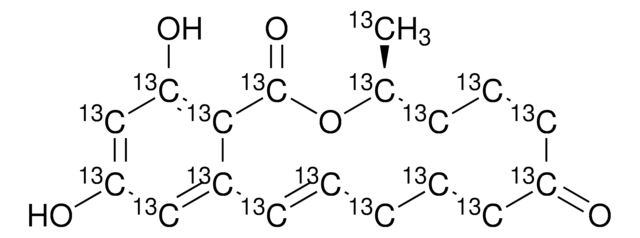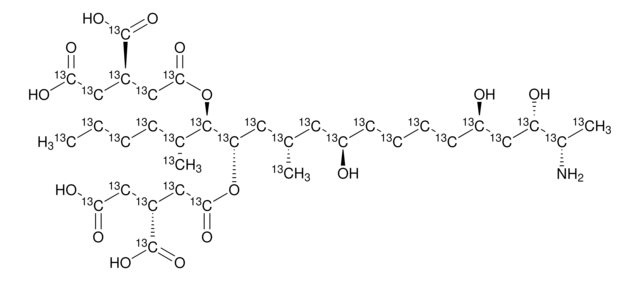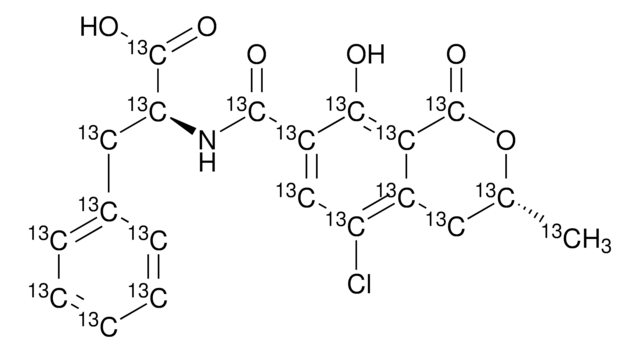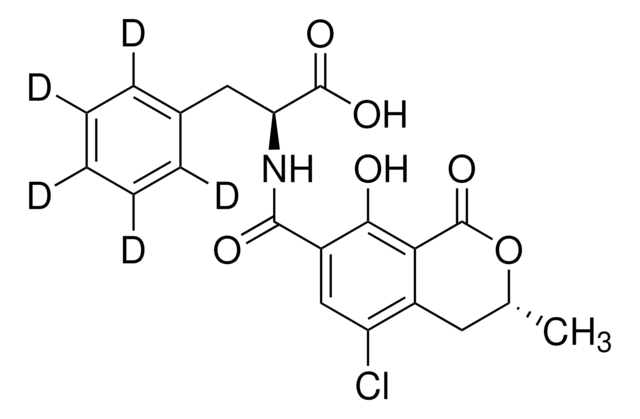34128
Deoxynivalenol-13C15 solution
~25 μg/mL in acetonitrile, analytical standard
Synonym(s):
13C15 DON, Fully 13C-labelled Deoxynivalenol
About This Item
Recommended Products
grade
analytical standard
shelf life
limited shelf life, expiry date on the label
concentration
~25 μg/mL in acetonitrile
technique(s)
HPLC: suitable
gas chromatography (GC): suitable
application(s)
cleaning products
cosmetics
environmental
food and beverages
personal care
format
single component solution
mass shift
M+15
storage temp.
−20°C
SMILES string
[13CH3][13C]1=[13CH][13C@H]2O[13C@@H]3[13C@H](O)[13CH2][13C@@]([13CH3])([13C@]34[13CH2]O4)[13C@@]2([13CH2]O)[13C@H](O)[13C]1=O
InChI
1S/C15H20O6/c1-7-3-9-14(5-16,11(19)10(7)18)13(2)4-8(17)12(21-9)15(13)6-20-15/h3,8-9,11-12,16-17,19H,4-6H2,1-2H3/t8-,9-,11-,12-,13-,14-,15+/m1/s1/i1+1,2+1,3+1,4+1,5+1,6+1,7+1,8+1,9+1,10+1,11+1,12+1,13+1,14+1,15+1
InChI key
LINOMUASTDIRTM-YGEUXOLBSA-N
General description
Deoxynivalenol-13C15 (13C15-DON) is the 13C isotope-labelled analog of mycotoxin, Deoxynivalenol. It is a fusarium mycotoxin which belongs to trichothecene class of compounds.
Application
- Maize by high performance liquid chromatography (HPLC) electrospray ionization (ESI) mass spectrometry (MS/MS).
- Cereals and cereal-based compound animal feeds by LC-MS/MS operating on selected reaction monitoring (SRM) mode.
- Bioaerosols collected from Serpula lacrymans−damaged homes by HPLC-MS/MS in multiple reaction monitoring (MRM) mode.
- Bread samples by reversed-phase HPLC-ESI with linear trap MS/MS.
It may also be used as an internal standard for the determination of HT-2 toxin, nivalenol and patulin in bioaerosols obtained from dairy cattle shed by HPLC-MS/MS.
Other Notes
Signal Word
Danger
Hazard Statements
Precautionary Statements
Hazard Classifications
Acute Tox. 4 Dermal - Acute Tox. 4 Inhalation - Acute Tox. 4 Oral - Eye Irrit. 2 - Flam. Liq. 2
Storage Class Code
3 - Flammable liquids
WGK
WGK 2
Flash Point(F)
35.6 °F
Flash Point(C)
2 °C
Choose from one of the most recent versions:
Already Own This Product?
Find documentation for the products that you have recently purchased in the Document Library.
Customers Also Viewed
Our team of scientists has experience in all areas of research including Life Science, Material Science, Chemical Synthesis, Chromatography, Analytical and many others.
Contact Technical Service










